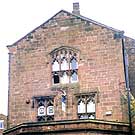Common Hall

Base layers
Data layers

Venue Type & Location
Site Name: Common Hall
Location: Chester
County: Cheshire
Location Type: Town - in town at determined location
Overview
Located in St Werburgh's Street at the intersection with Northgate Street, the former St Nicholas' Chapel stands on the SW corner opposite Chester Cathedral.
Most of the original fabric remaining is on the S side of the former common hall along Music Hall Passage, running E from Northgate Street.
Performance History
As the seat of civic government and the centre for festive occasions, the common hall was probably the venue for most performances by touring entertainers before the mayor and city officials before 1642.
In 1615 an ordinance banned performances in the common hall at night.
Current Status
Currently a pharmacy.
History of the Venue
Mid-14th c. Built by the monks of St Werburgh's for the parishioners' use as St Nicholas' Chapel.
1488 Some enlargement of the chapel.
1490 The citizens refused to use the chapel, eventually returning to the S transept of the abbey. St Nicholas' Chapel became vacant.
1546 St Nicholas' Chapel was acquired by the city and converted into the Chester Common Hall, replacing the former hall in Common Hall Lane. A floor was inserted dividing the building horizontally. The lower room was used for storage of trade goods like wool, corn and cloth. The upper chamber served for assemblies, elections and courts.
'The windows were decorated with stained glass with the arms of various prominent city families' (Bethell, Portrait of Chester 85).
1698 A new common hall was built on the site of the Old Shambles in Northgate Street.
1773 Used as the New Theatre. Walls raised by 15', windows renovated, high-pitched oak roof removed and interior converted (Hughes, Chronicle of Chester 191).
1777 Licensed as the Theatre Royal.
1855 Partly demolished except for the more substantial stone work and renovated by the architect James Harrison as a music hall.
20th c. Other uses for this building included a cinema, a supermarket and a men's clothiers shop.
Record Source
REED Chester 178, 219, 443
Bibliographic Sources
-
Bethell, David. Portrait of Chester. London: Robert Hale, 1980.
-
Carrington, Peter. Book of Chester. London: B.T. Batsford/English Heritage, 1994.
-
Harris, B.E., C.P. Lewis, and A.T. Thacker. The Victoria History of the County of Chester. The Victoria History of the Counties of England. 5 vols. Oxford: Oxford UP, 1979–2005.
-
Harris, Brian. Chester. Bartholomew City Guides. Edinburgh and London: John Bartholomew & Son, 1979.
-
Harrison, Simon, Annette M. Kennett, Elizabeth J. Shepherd and Eileen M. Willshaw. Tudor Chester: A study of Chester in the reigns of the Tudor Monarchs, 1485–1603. Chester: Chester City Record Office Historical Publications, 1986.
-
Hughes, Herbert. Chronicle of Chester: The 200 Years, 1775–1975. London: Macdonald & Jane's, 1975.
-
King, Daniel. The Vale-Royal of England or the County Palatine of Chester Illustrated. London: John Streater, 1656.
-
Mee, Arthur. Chester. London: St. Hugh's P, 1950.
-
Morris, Rupert H. Chester in the Plantagenet and Tudor Reigns. np: npub, nd.
-
Pevsner, Nikolaus, and Edward Hubbard. Cheshire. The Buildings of England. Harmondsworth, Midd: Penguin Books, 1971.
-
Pigott, I.M.B. History of the City of Chester. Chester: T. Poole, 1815.
-
Tittler, Robert. Architecture and Power: The Town Hall and the English Urban Community c. 1500–1640. Oxford: Clarendon P, 1991.
-
Windle, Bertram C.A. Chester: A Historical and Topographical Account of the City. London: Methuen & Co., 1903.






